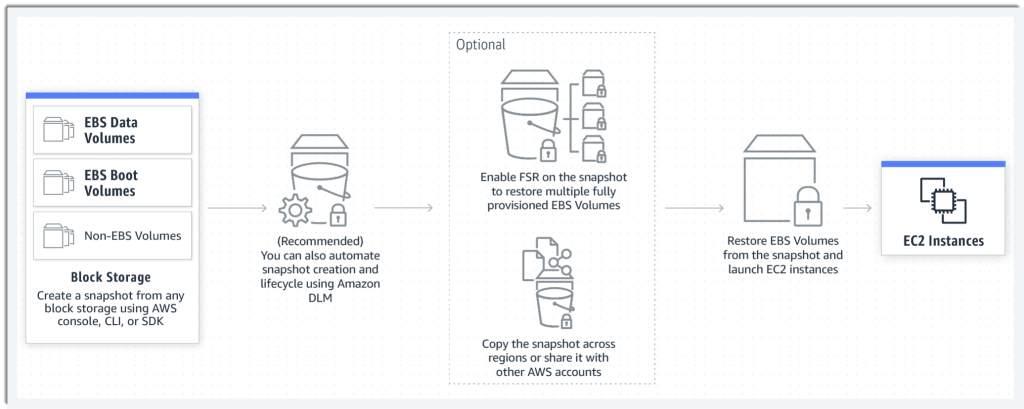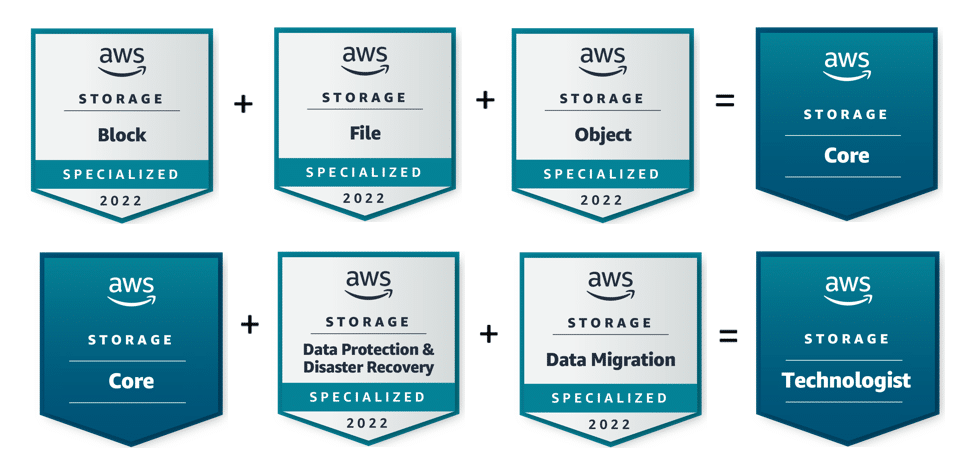The fourth annual AWS Storage Day highlighted features for Amazon Elastic Block Store (Amazon EBS), the new Amazon File Cache service, updates to the AWS Transfer Family of products, and five new AWS Storage Learning Badges. The updates and new services are geared toward reducing and optimizing storage costs while continuing to focus on data protection and resiliency.
The fourth annual AWS Storage Day highlighted features for Amazon Elastic Block Store (Amazon EBS), the new Amazon File Cache service, updates to the AWS Transfer Family of products, and five new AWS Storage Learning Badges. The updates and new services are geared toward reducing and optimizing storage costs while continuing to focus on data protection and resiliency.
Amazon EBS
Customers use Amazon EBS for high-performance workloads using critical applications like SAP, Oracle, and Microsoft. A key feature in Amazon EBS is the ability to back up volumes at any time using EBS Snapshots. Snapshots retain the data from all completed I/O operations, making it possible to restore a volume to the exact state at the moment before backup.
Snapshots are used in customers’ backup and disaster recovery plans. EBS snapshots can be created for each EBS Volume individually, or create a multi-volume snapshot of EBS volumes attached to a single Amazon Elastic Compute Cloud (EC2) instance. AWS has announced crash-consistent snapshots for a subset of the EBS volumes feature.

Before the release of this new feature, creating multi-volume snapshots of EBS volumes attached to a single Amazon EC2 instance required making multiple API calls to keep some, but not all, the snapshots. Now, there is the ability to choose specific volumes to exclude in the create-snapshot process using a single API call or the Amazon EC2 console, resulting in significant cost savings.
Crash consistent snapshots for a subset of EBS volumes are also supported by Amazon Data Lifecycle Manager policies to automate the lifecycle of multi-volume snapshots. Crash consistent snapshots are available now at no additional cost.
Amazon File Cache
Amazon has announced a new service on AWS that accelerates and simplifies hybrid cloud workloads. Amazon File Cache, available later this year, provides a high-speed cache to make it easier to process file data, no matter where the data is stored. Amazon File Cache is a temporary, high-performance storage location for data stored in on-premises file servers, in file systems, or in object stores in AWS.
With the new service, dispersed data sets are available to file-based applications on AWS with a unified view and at high speeds with sub-millisecond latencies and up to hundreds of GB/s throughput. Amazon File Cache has been designed to enable a variety of cloud bursting workloads and hybrid workflows, ranging from media rendering and transcoding to electronic design automation (EDA) to big data analytics.
AWS Transfer Family
Announced initially during Storage Day 2020, AWS Transfer Family server endpoints could be deployed in Amazon Virtual Private Clouds (VPCs), making it easy to manage and share data with simple, secure, and scalable file transfers. AWS Transfer Family provides a seamless path to migrate, automate, and monitor file transfer workflows into and out of Amazon S3 and Amazon Elastic File System (Amazon EFS) using SFTP, FTPS, and FTP protocols. That exchanged data is natively accessible in AWS for processing, analysis, and machine learning and can be integrated with applications running on AWS.

In late July, Transfer Family launched support for Applicability Statement 2 (AS2) protocol. This opens the door for healthcare and life sciences, retail, financial services, and insurance verticals that rely on AS2 for business-critical data exchange to use AWS Transfer Family AS2 endpoints for a more cost-effective and secure exchange vehicle.
Now, AWS has announced the AWS Transfer Family Delivery Program as part of the AWS Partner Network (APN) Service Delivery Program (SDP). Partners delivering cloud-native Managed File Transfer (MFT) and business-to-business (B2B) file exchange solutions using AWS Transfer Family can join the program.
Five New AWS Storage Learning Badges
In February, AWS announced digital badges that align with Learning Plans for Block Storage and Object Storage on AWS Skill Builder. AWS has announced five additional storage learning badges. Three digital badges align with the Skill Builder Learning Plans in English for File, Data Protection & Disaster Recovery (DPDR), and Data Migration. The other two badges, Core and Technologist, are tiered badges awarded to individuals who earn a series of Learning Plan-related badges.

To learn more, visit the AWS Learning Badges page.
Engage with StorageReview
Newsletter | YouTube | Podcast iTunes/Spotify | Instagram | Twitter | TikTok | RSS Feed
